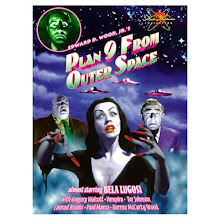Friday, September 12, 2008
Not Bad (at All) Lands
by Jason Pyles
I love movies that could actually happen but shouldn’t. Life’s full of things like that. Freak accidents and weirdoes abound. Take the spelling of “weirdoes,” for example. It just doesn’t seem right, does it?
And so is the saga of Kit Carruthers and Holly Sargus, two kids that appear to be dumber than a hoe handle.
The opening shots of “Badlands” are telling. We see Holly sharing her bed with an animal, a big dog. Foreshadowing. After she meets Kit and is discussing the encounter with her father, we see her sitting to the left of the screen with a huge sign pointing in her direction that reads “BAIT.”
What makes the movie for me, right off the bat, is the dialogue, particularly Kit’s verbal oddities, such as “I’ll give you a dollar [if] y’eat this collie.”
Or his hilarious grasp for the obvious: “Somebody dropped a bag on the sidewalk.” Then, a second later: “You’re a redhead!” We quickly get the impression that Kit doesn’t think too much; no, whatever pops into his head falls out of his mouth immediately. Not only does he think out loud, he behaves out loud, too — like when he shot his buddy Cato and regretted it soon thereafter.
This character development lends credibility to Kit’s nature. He’s obviously a zero, so we’re not all that surprised when he starts shooting people and burning down Holly’s home. And we only wince a little when Kit dreams up brilliant ideas like this one:
“You know what I think? We should crunch our hands with this stone. That way we’d never forget what happened today.”
This guy is an idea giant.
“Badlands” pays attention, though. It has some echoes of justice, like when Holly’s father mercilessly shoots her dog as punishment, then the same thing befalls him. The only thing I didn’t “buy” about this movie was Holly’s reaction (or lack thereof) to her father’s murder, but it turns out, that element was apparently true to the events that inspired this story. As I said, “ … things that could actually happen but shouldn’t.” (I guess the other hard-to-swallow- element of “Badlands” is the elaborate jungle-home that rivals the Ewok village. I don’t think so.)
It’s undeniable, though, that “Badlands” closely mirrors the story of Bonnie and Clyde. In fact, “Badlands” was released just six years after Arthur Penn’s “Bonnie and Clyde,” starring Warren Beatty and Faye Dunaway. Indeed, “Badlands” was actually quite tame after the groundbreaking violence (for U.S. film) depicted in “Bonnie and Clyde.”
And again, in 1994, we have “Natural Born Killers,” Oliver Stone’s critique on how the American media glamorizes and “celebritizes” notorious menaces to society, like serial killers. We get a little bit of that, too, at the end of “Badlands.” Perhaps this movie influenced Stone.
We also get other neat touches that show us that Terrence Malick, the writer, producer and director of this film, cared about this project: For instance, how many movies have a stereopticon? Or a Dictaphone? Or a message-carrying balloon? Or the burying of a time capsule — as well as a serial killer?
No, there’s really no point to this movie, other than the dramatization of the Starkweather-Fugate killing spree of the late ‘50s, upon which “Badlands” is based.
For those who are interested, according to the Lincoln City Libraries Web site, Charles Starkweather and Caril Fugate are still, to this day, considered Nebraska's most notorious mass murderers. Their horror story began when Starkweather, 19, killed a gas station worker in December of 1957. In January 1958, Starkweather and his 14-year-old girlfriend Fugate began an eight-day murdering spree that started with the murder of her family, and eventually led to 10 deaths before they were captured outside of Douglas, Wyoming. Starkweather was convicted of murder and executed at the Nebraska State Penitentiary in 1959. Fugate was also convicted and her initial life sentence was commuted to a 30- to 50-year sentence in 1973. But in 1976, after serving 18 years, Fugate was paroled and eventually resettled in Michigan.
Truth is stranger than fiction. But you see what I mean? This kind of stuff — and worse — could happen, and does happen. (Someday we should discuss the merit, if you believe there is any, in depicting such atrocities of humanity in film. I believe there can be merit in such depictions.)
But if I had to identify a point to “Badlands,” and what makes it intriguing, is the shocking nature and unexpected turn of events associated with their adventure. It’s like Holly says in her voice-over narration, “It all goes to show how you can know a person and not know ‘em at the same time.”
Or, like Floyd "Mac" McClure of "Gates of Heaven" said: "When I turn my back, I don't know you, not truly. But I can turn my back on my little dog, and I know that he's not going to jump on me or bite me. But human beings can't be that way."
I suppose that's true to some extent. I always expect the end of "CSI" to reveal some monster, but the murderer is always just a regular-looking human being. Maybe the only difference between us and a criminal is at least one really bad decision. Yes, we unpredictable humans will surely supply the cinema with an everlasting source of subject matter ... and the justice system with never-ending clients.
Subscribe to:
Post Comments (Atom)






























































No comments:
Post a Comment